| 16-35mm |
$1,865 average price |
|---|---|
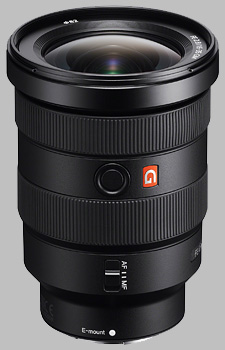
|
|
Your purchases support this site
Buy the Sony FE 16-35mm f/2.8 GM SEL1635GM
Updates
05/17/2017: Hands-On Preview posted
08/18/2017: Field Test posted & Gallery updated
Sony FE 16-35mm f/2.8 GM Field Test
Top-notch results from a long-awaited Sony FE lens
by Eamon Hickey | Posted 08/18/2017
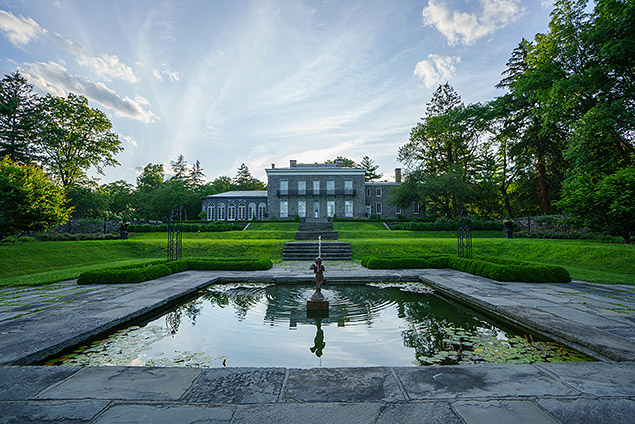 |
|
Sony A7R II: 16mm, f/11, 1/40s, ISO 100
The Bartow-Pell Mansion in The Bronx. Converted from raw in Adobe Lightroom: click image for JPEG or here for the RAW file. |
If you haven't read our hands-on report on the new Sony FE 16-35mm f/2.8 GM lens by Jaron Schneider, it might be a good idea to give it a look. In this Field Test, I'll try to augment Jaron's comments and talk about a couple of additional features and functions of this excellent optic. As Jaron noted, the FE 16-35mm f/2.8 is an important addition to Sony's full-frame mirrorless FE lens lineup. It fills out the company's so-called "holy trinity" of professional zooms -- the wide, mid, and telephoto f/2.8 zooms lenses that are a key requirement of any general-purpose professional camera system.
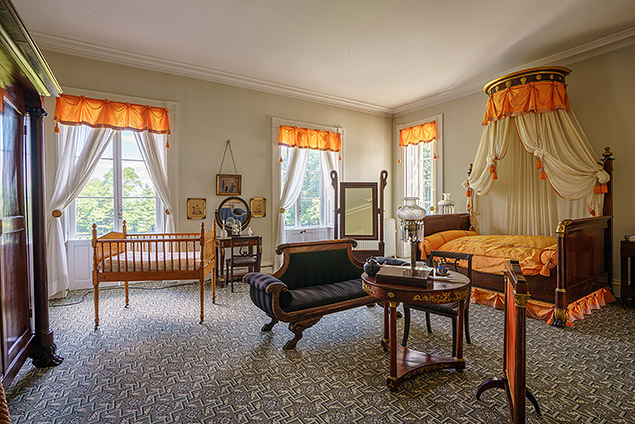 |
Sony A7R II: 17mm, f/11, 1/10s, ISO 100, -3EV A composite HDR image of the interior of the Bartow-Pell Mansion in The Bronx. At 16mm, the lens can capture most of a room from one corner. Converted from raw in Adobe Lightroom: click image for JPEG or here for the RAW file. |
One thing I should note: I have never used Sony's other 16-35mm lens, the FE 16–35 mm F4 ZA OSS. That means I can't compare the two in this Field Test, other than to point out the obvious, which is that the f/2.8 G Master lens opens a stop wider -- which can be a big deal to some photographers -- and is over $800 more expensive.
 |
Sony A7R II: 28mm, f/8, 10s, ISO 50 Boats blur in this 10-second exposure of a marina in Brooklyn Bridge Park, with Lower Manhattan in the distance. Shot with a 10-stop neutral density filter and corrected for the corner shading that the filter adds. Converted from raw in Adobe Lightroom: click image for JPEG or here for the RAW file. |
Of course, the first thing I did when I received the lens was check out its mechanical construction. As you would expect of a key professional lens, the FE 16-35mm f/2.8 feels extremely well made. It's solid in the hand, and the fit and finish are excellent. It has a rubber gasket at the lens mount (and more inside the lens, according to Sony) to add some weather resistance, and it mounts onto the camera body (in my case, an A7R II) with satisfying precision. Both the zoom and focus rings have a smooth, well-damped feel. After using it on a dozen shoots, I'd say the focus ring may offer a tad less resistance than I personally would prefer. That said, I could fine-tune manual focus very precisely with it, and it never wandered from where I set it in practical use. The AF/MF switch, which is located in just the right spot on the left side of the lens, was extremely handy for switching between auto and manual focus; I used it all the time on my shoots. Although I didn't use it in my shooting, I'd say the focus hold button is also well positioned, within easy reach of your left thumb.
A "petal" style lens hood is included with the FE 16-35mm f/2.8. Made of relatively thin plastic, it's nothing particularly special, but it bayonets on quite easily for both picture-taking and, reversed, for storage.
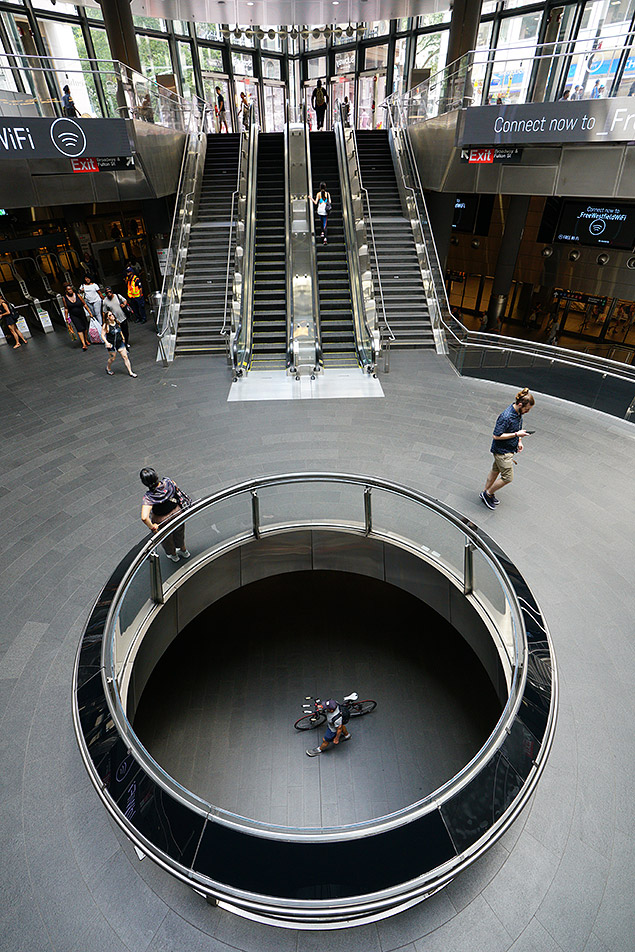 |
Sony A7R II: 16mm, f/5.6, 1/125s, ISO 1000 The 16mm view captures three levels of activity at the Fulton St. train station. |
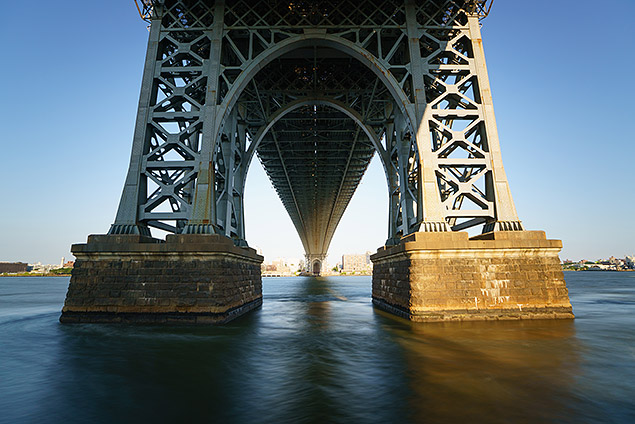 |
Sony A7R II: 16mm, f/8, 8s, ISO 200 The East River flows around the base of the Williamsburg Bridge in this 8-second exposure. Shot with a 10-stop ND filter and partially corrected for the corner shading the filter adds. Converted from raw in Adobe Lightroom: click image for JPEG or here for the RAW file. |
After getting a feel for the FE 16-35mm f/2.8 GM, I started shooting. I wanted to try it out for a broad range of the things a wide-angle zoom can be used for, from landscapes and architecture to interiors, interesting perspective shots, and general street- and travel-style pictures. Because New York City is fundamentally a harbor city, I also became a little obsessed with trying to get some interesting water shots, especially long exposures during daylight. For those, I used a couple of different neutral density filters, including a 10-stop filter that I tested pretty carefully to make sure it didn't visibly detract from the sharpness of the lens.
I also made a special effort to shoot a range of images with significant background blur, because Sony's marketing materials for the FE 16-35mm f/2.8 stress claims about the good bokeh qualities of this lens.
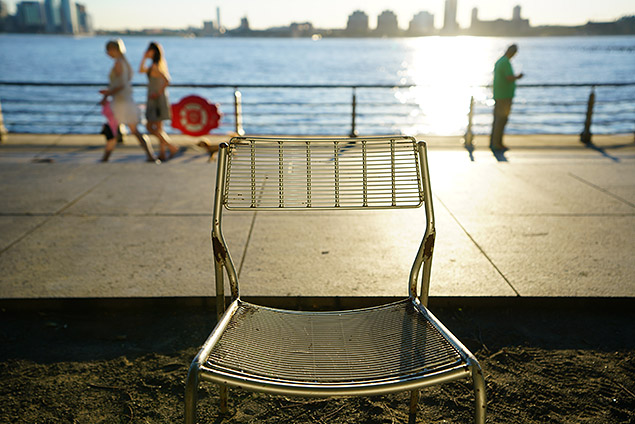 |
Sony A7R II: 35mm, f/2.8, 1/1000s, ISO 100, -0.3EV An example of bokeh at 35mm. |
My experience with using the FE 16-35mm f/2.8 GM across all those different days and situations was uniformly excellent -- never a glitch or any unpleasant surprise of any kind. It's not exactly light to carry around, but its efficient design makes it a breeze to use. For me, this lens had no annoying quirks -- say, a wonky hood, or a zoom or focus ring that's too easy to inadvertently move -- that can mar some otherwise great optics. It focuses very quickly and precisely in autofocus mode. And as I mentioned above, using it in manual focus mode is easy and precise, which is a big plus. For critical landscape and architectural images using a camera like the A7R II, which has a very good manual focus magnification feature, I always focus manually. One thing to note is that, like many lenses, the FE 16-35mm f/2.8 can focus slightly past infinity, so if you're setting up a landscape shot and want to focus at infinity, it's important to actually check the focus, as opposed to simply turning the focus ring to its furthest extreme.
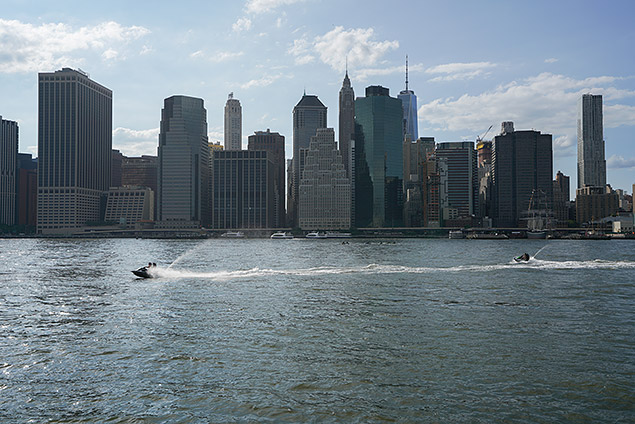 |
Sony A7R II: 35mm, f/8, 1/800s, ISO 100 Lower Manhattan from Brooklyn Bridge Park shows the sharpness of the lens at 35mm, f/8. Converted from raw in Adobe Lightroom: click image for JPEG or here for the RAW file. |
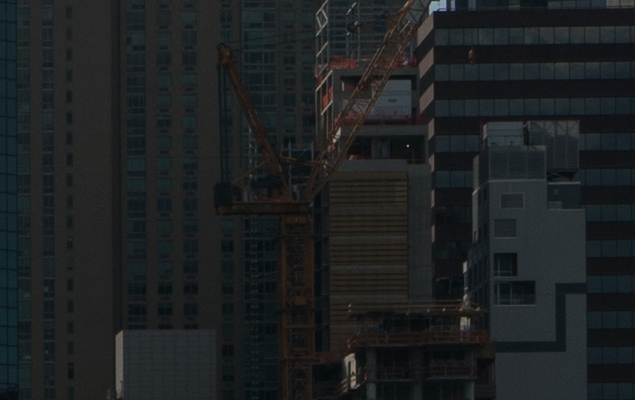 |
A 100% crop from the unedited raw file (opened in Photoshop with ACR default settings). |
In my real-world test images, just as Jaron found in his hands-on report, the FE 16-35mm f/2.8 is extremely sharp from corner to corner at nearly all apertures and focal lengths. It especially shines on the 42-megapixel A7R II camera that I was using; very fine, very distant details are easily visible in my cityscape shots. At 16mm and f/2.8, at the outer edges, I can see a modest drop-off in sharpness, and there's a tiny bit of edge softness at other focal lengths as well at f/2.8. But otherwise it's very difficult to see any sign of even modest softness in this lens. I also shot many pictures at close focusing distances and here again, every properly focused image I shot is very crisp.
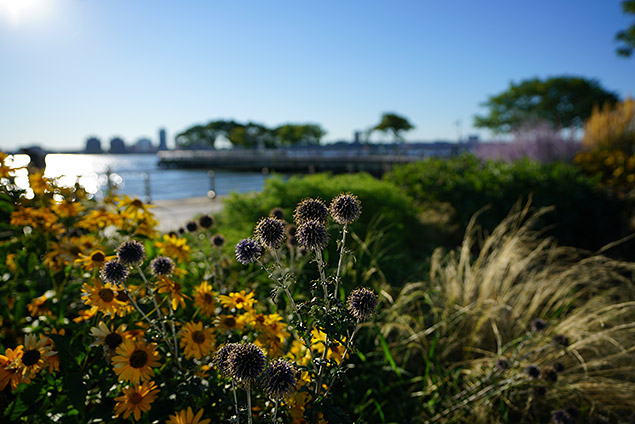 |
Sony A7R II: 24mm, f/2.8, 1/2000s, ISO 100, -0.7EV Fairly smooth bokeh at 24mm and f/2.8. Even with the sun in the corner of the frame, there's no visible flare or contrast loss. |
That sense of crispness is, of course, also partly due to the high level of contrast that the FE 16-35mm f/2.8 renders, again at all apertures. It just makes brilliant and punchy images. On a high resolution camera like the A7R II, it can easily provide the sharpness needed to make very big enlargements of highly detailed subjects like fine-art landscapes or architecture. It's impossible for me to quantify its sharpness precisely from real-world images that weren't shot in perfectly controlled conditions. But in practical use, the FE 16-35mm f/2.8 16-35mm f/2.8 always totally impressed me with regard to capturing fine details.
 |
Sony A7R II: 16mm, f/2.8, 1/400s, ISO 100 Bokeh is perhaps a little less smooth at 16mm than at longer focal lengths, but still fairly neutral. |
The first optical flaw, to use too strong a word, that I actually noticed in my test pictures was modest barrel distortion at 16mm. It's not particularly bad, but it's strong enough that I would want to correct it in post-processing for some images. It also seems to have a slight so-called "mustache" shape to it. The distortion correction function in the A7R II (for JPEGs) and in Sony's Image Data Converter software compensates for this distortion essentially perfectly. As of this writing, there is no automatic correction profile for this lens for Adobe Lightroom, and my manual corrections in Lightroom were a little bit less successful than Sony's, leaving some of the mustache shape behind. I don't really think this would ever matter in real life, at least to me, and it's a sure bet that the major raw converter programs will soon have profiles for this lens that will likely be as good as Sony's.
I also saw a very small amount of pincushion distortion at 35mm, but I would rarely need to correct this at all, and it was very straightforward to fix.
Jaron saw very little chromatic aberration in his hand-on test, and I also have seen very little. In fact, I have not detected any standard lateral chromatic aberration in test images viewed at 100% in Lightroom. In a few images, I've seen a small amount of longitudinal (a.k.a. axial) chromatic aberration, but it really is negligible. In short, this lens has fantastic chromatic aberration control overall.
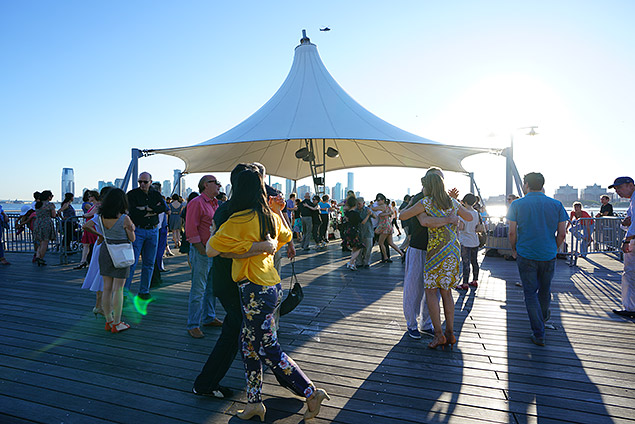 |
Sony A7R II: 19mm, f/5.6, 1/160s, ISO 100, +0.7EV The sun in the upper right of the frame causes one distinct green flare patch, but contrast remains good. |
On two of my shoots, I made some fairly intensive efforts to get the FE 16-35mm f/2.8 16-35mm f/2.8 to flare. It's not easy -- this lens is really resistant to visible flare. Even with the sun in the frame, or just at the edge, the lens retains extremely good contrast. Really impressive. In some of my torture tests, I could induce green flare patches, and even in one case, a kind of rainbow patch. Even in these images, contrast is still quite good. And I have lots of test shots with the sun in the frame or just outside of it that show no evidence of flare. I have no doubt that the coating technology on the FE 16-35mm f/2.8 is fantastically effective.
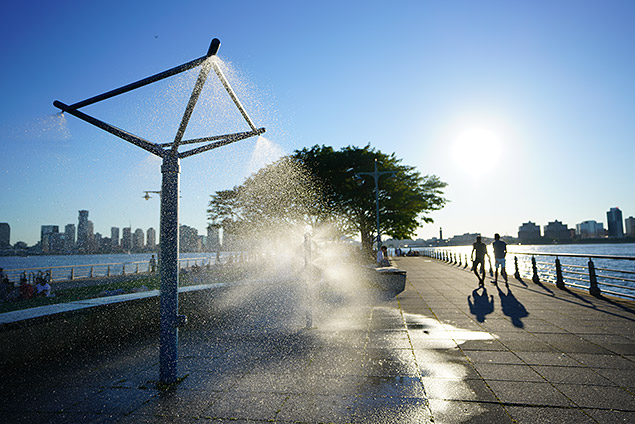 |
Sony A7R II: 23mm, f/2.8, 1/2000s, ISO 100, +0.7EV The sun is in the frame but there's good contrast and detail, and no visible flare. |
The second optical issue that rises to the level of possibly needing correction in my images from the FE 16-35mm f/2.8 GM is vignetting, or corner shading. At the wider end of the zoom range, vignetting is definitely noticeable at wide apertures, especially f/2.8. Some corner shading is still present even at f/8. The A7R II has a built-in correction function for corner shading in JPEGs, but it does not completely eliminate it (a good design choice, in my opinion). Raw images show a fair bit more shading. At the wider apertures, it's certainly strong enough that I would want to correct it in landscape and architectural style shots.
The shading gets progressively milder as you zoom towards 35mm, where it's light at f/2.8 and virtually nonexistent at f/8, in my test shots.
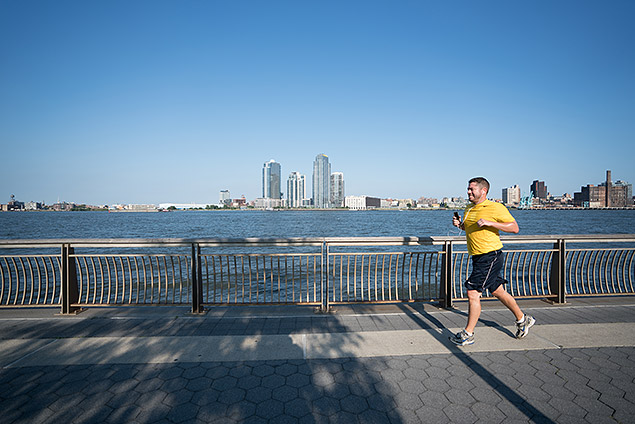 |
Sony A7R II: 16mm, f/2.8, 1/1600s, ISO 100, +0.3EV This image shows uncorrected corner shading at 16mm, f/2.8. Converted from raw in Adobe Lightroom: click image for JPEG or here for the RAW file. |
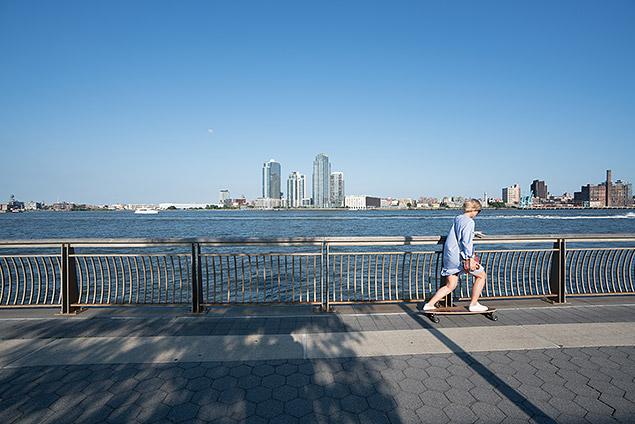 |
Sony A7R II: 16mm, f/8, 1/200s, ISO 100, +0.3EV This image shows uncorrected corner shading at 16mm, f/8. Converted from raw in Adobe Lightroom: click image for JPEG or here for the RAW file. |
Sony really touts the bokeh characteristics of the FE 16-35mm f/2.8 GM, and I think their claims largely hold up. Different photographers have different ideas about what constitutes good bokeh, but I believe Sony is basing their claims on the ideal of smooth, non-distracting out-of-focus blur, which also happens to be what I prefer. Even at 16mm, where I think the bokeh of the FE 16-35mm f/2.8 is harshest, it's still fairly calm and neutral. In my tests at 24mm and 35mm focal lengths, the bokeh is generally quite smooth, both wide open and stopped down to f/4.
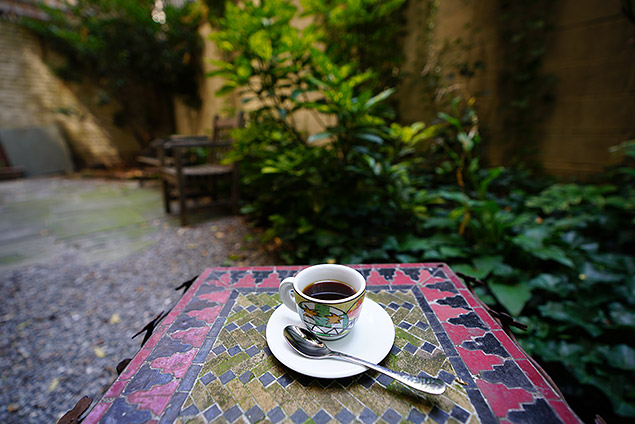 |
Bokeh at 16mm, f/2.8. |
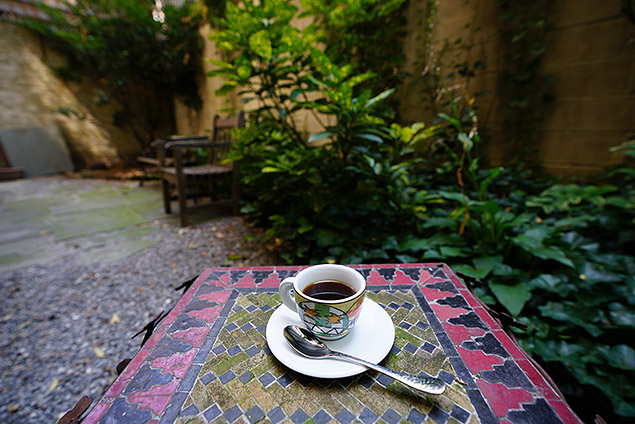 |
Bokeh at 16mm, f/4. |
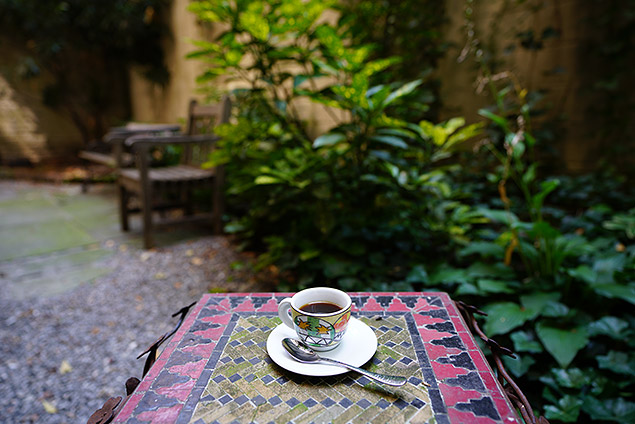 |
Bokeh at 24mm, f/2.8. |
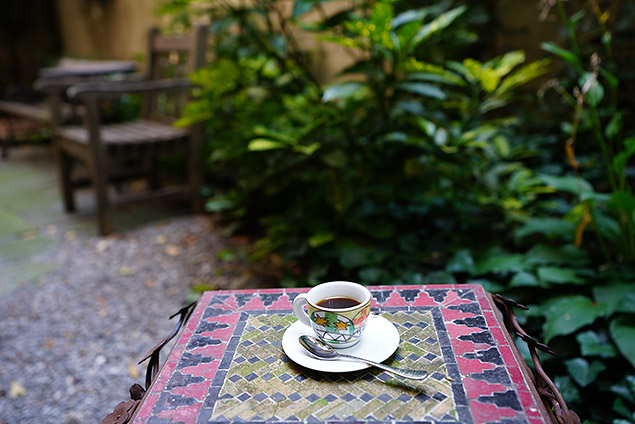 |
Bokeh at 35mm, f/2.8. |
I haven't specifically tested competing pro wide-angle zooms for bokeh, but I've shot with many, many wide-angle lenses of all types over the years. Bokeh quality is not generally a point of emphasis with wide-angle lenses, since they're generally not used for shots with significant background blur anywhere near as much as normal and telephoto focal lengths. As a result, many of them, if not most, can have a busy look to their background blur, in my experience. It does seem to me that the FE 16-35mm f/2.8 has unusually smooth and calm bokeh compared to most of the wide-angles I've used. It's also something I would value highly in a purchase decision, since I sometimes like shooting close-up subjects with wide-angles, and I'm a fan of smooth blur. Kudos to Sony for delivering on this promise without, as far as I can tell, sacrificing the quality of the lens in other ways.
My overall opinion of the FE 16-35mm f/2.8 GM lens is easy to sum up: what's not to like? It's sturdy, super efficient to use, and produces fantastic images in all kinds of situations. If I owned one, I would be prepared to do some distortion correction and some vignetting compensation in some images. But otherwise, there just is nothing lacking in the pictures this lens makes. In almost any practical situation I can think of, the FE 16-35mm f/2.8 will deliver top-notch results for pros and serious amateurs alike. That makes it a great -- and very important -- addition to Sony's mirrorless lens lineup.
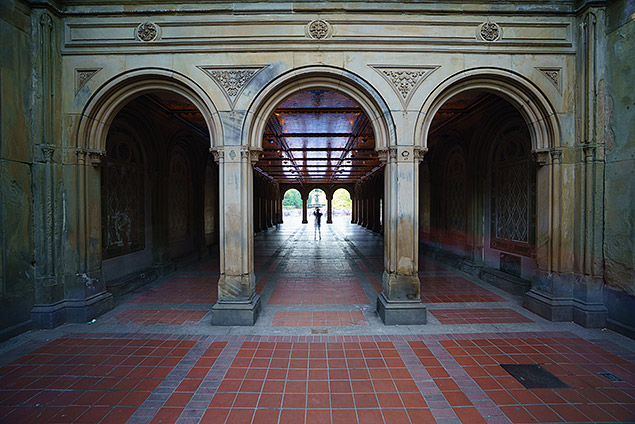 |
Sony A7R II: 16mm, f/8, 15s, ISO 100 This long exposure of a ghostly smartphone photographer in Central Park shows the barrell distortion of the FE 16-35mm f/2.8 at 16mm, including the slight mustache shape along the top edge. Converted from raw in Adobe Lightroom: click image for JPEG or here for the RAW file. |
Sony FE 16-35mm F2.8 GM Review -- Hands-On
by Jaron Schneider | 05/17/2017
Though a Zeiss 16-35mm f/4 was already available to Sony E-mount users, Sony spoke about their newest f/2.8 full-frame wide-angle lens with great pride. The optic that was missing to fill out their "holy trinity" of G-Master zooms is here, and it doesn't disappoint. With what appears to be excellent sharpness, great aberration and flare control, superb autofocus accuracy and speed topped off with a solid body design, the FE 16-35mm f/2.8 looks like it is exactly what Sony fans have been waiting patiently for.
Autofocus
Thanks to two direct drive SSM actuators and a floating focus control system, the autofocus acquisition is spectacularly fast, even on cameras not typically associated with extreme autofocus speed like the A7R II. I was shocked at how quickly I was able to turn the camera on, put the viewfinder to my eye, and fire a shot, and then be rewarded with a perfectly sharp image. This happened multiple times in test shooting while I was managing two cameras in an action-oriented situation. At the time I was rather taken aback at how this was happening, as it was not an experience I expected based on shooting with the A7R II in the past. Something about this lens' autofocusing system puts it several steps beyond what I considered normal.
If the picture I pained about this lens' capabilities on the slower-shooting A7R II whet your palate, then you should have a pretty solid picture of how well the lens performed on the A9. As expected, it was phenomenal. Outside of my user error on a couple occasions, the lens never missed focus or failed to acquire a target.
In high-contrast or backlit situations, the lens performed better than expected. Focusing was quick and accurate with nearly no exceptions.
Image Quality
Sony equipped the FE 16-35mm with two extra low dispersion glass elements to minimize chromatic aberration and also employed their Nano AR coating to suppress internal reflections. What results is a lens that fights flare and chroma extremely well. In my images, I did not see nearly any flare at all, and only a few images with what appears to be a bit of chromatic aberration. However, I looked that a few images a friend of mine took and those exhibited more egregious levels of flare (though not much or any chroma). So while the lens does do a very good job minimizing flare, you can still manage to find some in your shots depending on the angle of your light source.
As far as sharpness is concerned, the Sony 16-35mm is pretty darn good. At nearly any aperture including wide open and at any focal length, subjects are consistently crisp and sharp. Thanks to an eleven-bladed diaphragm, the bokeh is really beautiful and the separation you can achieve contrasted with the sharpness is stellar.
Distortion is well controlled, and the promised corner-to-corner sharpness is there. It really is hard to find anything to complain about with this lens, as images taken with it just look amazing.
Overall
I was very impressed with the FE 16-35mm f/2.8 despite the limited time I had with it. On both the Sony A7R II and the A9 it focused extremely quickly and with pinpoint accuracy while delivering extremely sharp photos with beautiful bokeh. This is most certainly a lens to be excited about when it releases later this year.
Sony FE 16-35mm F2.8 GM Overview
(From Sony lens literature) Explore the world in creative new ways with superb G Master performance in a 16-35mm F2.8 wide-angle zoom. No matter what zoom setting or focus distance you shoot at this lens not only delivers consistently superb resolution from corner to corner, but also produces stunning background bokeh that can add depth and artistic impact to your images when required. A compact, lightweight design makes the FE 16-35mm F2.8 GM a great choice for active shooting.
- Superb resolution at all settings
- Extraordinarily smooth background bokeh
- Lightweight, compact and mobile
- Precise, quiet autofocus
- Professional control and reliability
Capture the world in spectacular detail
Exacting G Master design standards have resulted in a wide-angle zoom that delivers outstanding corner-to-corner resolution throughout its zoom and focus ranges. Two original XA (extreme aspherical) elements with extremely high surface precision are included, one of which is the largest ever produced. The XA elements work with three aspherical elements to minimize aberrations that commonly plagues wide-angle zooms. Two ED (Extra-low Dispersion) glass elements are also used to stop chromatic aberration. A floating mechanism driven by two DDSSM (Direct Drive SSM) actuators maintains outstanding resolution throughout the lens's zoom range, from infinity to close focus. Sony's own Nano AR coating boosts performance even further by suppressing internal reflections and maintaining clarity even in difficult outdoor lighting conditions. Capture your world with stunning sharpness, detail, and realism.
Controlled, beautiful bokeh adds expressive depth
The ability to produce background bokeh with a large-aperture lens is not unusual, but the smooth beauty of the bokeh from this lens is truly impressive. The XA elements and ED glass elements used not only deliver class-leading sharpness and clarity, but they add up to consistently smooth, creamy bokeh as well. An 11-blade aperture mechanism contributes too. Wide angles, an F2.8 maximum aperture, and G Master optics can elevate your art to unprecedented heights.
Compact and reliable
Class-leading size and weight reductions result in a lens that is mobile and manageable, while lens and body sealing enhances reliability for outdoor shooting.* A fluorine coating on the front element helps to prevent dirt and fingerprints from sticking, and makes it easier to wipe dirt and fingerprints away if they do become attached to the lens surface. This is a lens that can be used with confidence in a variety of challenging outdoor conditions.
*Not guaranteed to be 100% dust and moisture proof.
Sony FE 16-35mm f/2.8 GM SEL1635GM
Your purchases support this site
Sony E-mount - Black
Sony FE 16-35mm f/2.8 GM SEL1635GM User Reviews
-
No tech to wreck, all manual. Whoa, that wide angle perspective really brings out the much-needed depth of field when magnifying! Looks like this lens performs great on m4/3 and pretty good on FF.Looks like your lens needs to hit the gym, it's too heavy for that 95mm eq. lens!
Ah, the good olddays of using all sorts of lenses for macro photography! Well, some did well but lacked depth, and a bunch needed lengthy extensions.
reviewed June 12th, 2023
roofing contractors bonita springs | roofing contractors bradenton -
Superb resolution at all settingsa bit heavy but considered not cons.
No matter what zoom setting or focus distance you shoot at this lens not only delivers consistently superb resolution from corner to corner but also produces stunning background bokeh that can add depth and artistic impact to your images when required.
reviewed June 5th, 2023 -
Totally manual, no electronics to fail. Wide angle perspective gives very much needed apparent DOF at high magnification. Excellent on m4/3 and good on FF.Would have liked to to also cover x2.
I have used mine almost daily, for above 1:1, for about 2 years. I can take hand-held daylight shots in some situations, in bright sunlight but I prefer to use TTL, off-camera RC flash (2 units, occasionally 3). I never use a tripod.
reviewed March 7th, 2022
I previously used various legacy macro lenses, enlarger lenses or supplementary diopters. All gave good results but not the depth effect, and many of them required long extensions. -
Ultra sharp; Superb color rendering; Focus is reliable; Almost no chromatic aberration, distortion; Nice flare Weather resistantHeavy; Too big for 95mm eq. Lens
Great lens for landscape and taking slow object; build quality is solid; metal feel like Leica / hasselblad lenses.
reviewed March 3rd, 2022 -
stunning sharpness, detail, and realism.a bit heavy but considered not cons.
Given its modest size for an f/2.8 wide-angle zoom, vignetting is fairly low, even at the shortest focal length. Sharpness and contrast are spectacular and, as with the wider Sony FE 12-24mm lens, the Nano AR coating does an excellent job of fending off ghosting and flare.
reviewed February 3rd, 2022 (purchased for $850)
Joe Davidson -
Portability/compactness, good sharpness, decent bokeh.Nothing really except.
- Sharpness is very good in the center (most of the frame actually) wide open, while slightly soft in the extreme corners (only). Stopped down the center becomes great while the extreme corners get quite decent. 192.168.1.1
reviewed October 17th, 2020